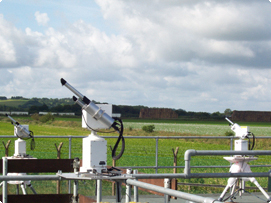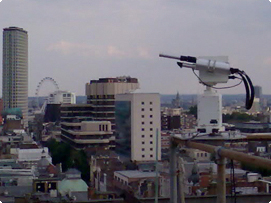The UK Sun Photometer Network
Published: Friday, July 25, 2008
With the increasing interest in climate change and global warming research, the effects of stratospheric aerosols are being studied in greater detail. Primarily, this refers to water vapour and suspended particles such as smoke, dust, sand and ash. These absorb and scatter solar radiation, act as nuclei for the formation of clouds and promote atmospheric chemical reactions.
Understanding atmospheric aerosols is one of the most important ways that scientists can improve models for weather and air quality forecasting and for climate change prediction. In order to gather information on the size and shape of particles it is necessary to measure the characteristics of light directly from the sun and also light scattered and absorbed by the aerosols, at angles up to 90° away from the sun. One of the most widely used instruments for this purpose is the POM Sky Radiometer, manufactured by Prede Co. Ltd. in Tokyo and distributed by Kipp & Zonen.
In 2001 the Remote Sensing Group of the Plymouth Marine Laboratory (PML) in the UK installed a POM-01 Sky Radiometer as part of an atmospheric correction exercise for ocean colour satellite data. Following consultation with PML, the MetOffice Research Centre at Cardington, Bedfordshire purchased a POM-01 for aerosol measurements. Then University College London (UCL) installed a POM-01 in the heart of London to compare ground-based aerosol measurements with satellite retrievals and to achieve a better understanding of aerosol transport from street canyon level to the planetary boundary layer and entrainment into the free atmosphere.

In 2007the British Antarctic Survey (BAS) in Cambridge decided to replace their Ångström Pyrheliometers for the measurement of stratospheric aerosols. These have been in service at the Rothera Antarctic Station since 1958 and each observation is manual, takes about 20 minutes, and requires calm conditions. Nowadays automated measurements are needed and BAS decided to purchase two POM-01 Sky Radiometers. Both units are installed at the Cambridge headquarters and another one will be transferred to Rothera Station in January 2008.
Plymouth is a coastal city and so the aerosols tend to be larger than those generated over land and contain a lot of salt particles. Cardington is an open inland site, Cambridge is semi-urban and London is a large city with the associated pollution and heat island effects. These four sites now form the basis of the UK sun photometer network.
The Natural Environment Research Council (NERC) runs the APPRAISE programme (Aerosol Properties, Processes And Influences on Earth’s Climate) and one activity is to validate aerosol optical depth, size distribution and refractive index measurements from sun photometers around the United Kingdom. Therefore, an inter-comparison of four POM-01 Sky Radiometers took place during Summer 2007 at the Chilbolton Facility for Atmospheric and Radio Research near Stockbridge, Hampshire. There are on-going discussions about how to fund expansion of the POM network in the United Kingdom.
This example from the United Kingdom shows how a network of measurement instruments can be built up over a number of years through institutes that have similar aims and are willing to co-operate to improve knowledge.
